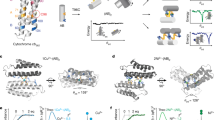Abstract
A ligand can shift a protein's folding/unfolding equilibrium by binding with higher affinity to the native state. A metal–chelating site consisting of two histidines separated by three residues (His–X3–His) engineered into an α–helix provides a general and easily–implemented means for protein stabilization by this mechanism. We have tested this approach with the iso–1–cytochrome c of Saccharomyces cerevisiae substituted with histidine at positions 4 and 8 in its N–terminal α–helix. One mM Cu(II) complexed to iminodiacetate stabilizes the cytochrome c variant by ca. 1 kcal/mol, as determined by guanidinium chloride–induced unfolding. The protein's folding/unfolding equilibrium is shifted by a free energy equal to that calculated from the metal ion's preferential binding to the native protein. Given the ubiquity of surface α–helices and the additional possibility of inserting di–histidine chelating sites into turns and β–structures, we conclude that this is a useful method for protein stabilization.
Similar content being viewed by others
References
Arnold, F.H. and Hayrnore, B.L. 1991. Engineered metal-binding proteins: purification to protein folding. Science 252: 1796–1797.
Roberts, V.A., Iverson, B.L., Iverson, S.A., Benkovic, S.J., Lerner, R.A., Getzoff, E.D. and Tainer, J.A. 1990. Antibody remodeling: a general solution to the design of a metal-coordination site in an antibody binding pocket. Proc. Natl. Acad. Sci. USA 87: 6654–6658.
Ghadiri, M.R. and Choi, C. 1990. Secondary structure nucleation in peptides. Transition metal ion stabilized α-helices. J. Am. Chem. Soc. 112: 1630–1632.
Iverson, B.L., Iverson, S.A., Roberts, V.A., Getzoff, E.D., Tanier, J.A., Benkovic, S.J. and Lerner, R.A., 1990. Science 249: 659–662.
Handel, T. and DeGrado, W.F. 1990. De novo design of a Zn2+ binding protein. J. Am. Chem. Soc. 112: 6710–6711.
Todd, R., Van Dam, M.E., Casimiro, D., Haymore, B.L. and Arnold, F.H. 1991. Cu(II) binding properties of a cytochrome c with a synthetic metal-binding site: His-X3-His in an α-helix. Proteins: Struct., Funct. & Genet. 10: 156–161.
Suh, S.-S., Haymore, B.L. and Arnold, F.H. 1991. Characterization of His-X3-His sites in α-helices of synthetic metal-binding bovine soma-totropin. Protein Engineering 4: 301–305.
Nall, B.T. and Landers, T.A. 1981. Guanidine hydrochloride induced unfolding of yeast iso-2-cytochrome c. Biochemistry 20: 5403–5411.
Pace, C.N. 1986. Determination and analysis of urea and guanidine hydrochloride denaturation curves. Meth. Enzymol. 131: 266–280.
Author information
Authors and Affiliations
Rights and permissions
About this article
Cite this article
Kellis, J., Todd, R. & Arnold, F. Protein Stabilization by Engineered Metal Chelation. Nat Biotechnol 9, 994–995 (1991). https://doi.org/10.1038/nbt1091-994
Received:
Accepted:
Issue Date:
DOI: https://doi.org/10.1038/nbt1091-994
- Springer Nature America, Inc.
This article is cited by
-
Aspergillus welwitschiae: A Potential amylases Producer
Current Microbiology (2022)
-
Mapping the structure and conformational movements of proteins with transition metal ion FRET
Nature Methods (2009)
-
Novel metal-binding proteins by design
Nature Structural & Molecular Biology (1995)




